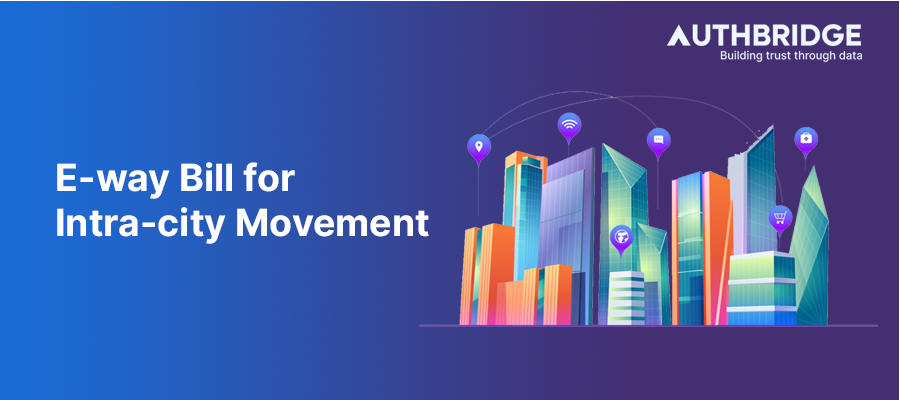Guidelines, Challenges, And Technological Solutions

The E-way Bill system under the GST framework mandates the electronic documentation of goods movement exceeding a certain value threshold. While primarily associated with inter-state and long-distance intra-state transport, E-way Bills also apply to intra-city movements under specific conditions, ensuring compliance and facilitating tax audits.
Applicability and Threshold Limits
For intra-city movement, the E-way Bill requirement kicks in for goods valued over Rs 50,000. However, certain states may impose different thresholds or exemptions based on the nature of goods or specific intra-city logistics scenarios.
Regulatory Framework for Intra-city E-way Bills
GST Council Guidelines
The GST Council provides overarching guidelines for E-way Bill generation, including intra-city movements. These guidelines aim to standardize the process across states while allowing for some regional flexibility.
State-specific Regulations and Exemptions
States have the authority to set specific rules for E-way Bill generation within city limits, including exemptions for certain goods or situations. Businesses must stay informed about these state-specific regulations to ensure compliance.
Generating E-way Bills for Short Distances
Step-by-Step Process
- Login to the E-way Bill Portal: Access your account on the official portal.
- Enter Details: Input the transaction details, including the nature of goods, value, and transport information.
- Generate E-way Bill: Submit the information to generate an E-way Bill, receiving an EBN for the movement.
Special Considerations for Intra-city Transport
For intra-city movements, accurately specifying the start and end points within the same city is crucial, along with understanding any state-specific exemptions that may apply.
Challenges and Solutions in Intra-city E-way Bill Compliance
Common Compliance Issues
Businesses often face challenges related to the accurate classification of goods, understanding exemptions, and managing the logistics of E-way Bill generation for short-distance deliveries.
Mitigating Risks and Ensuring Smooth Operations
- Stay Updated: Regularly review state-specific regulations and exemptions.
- Use Technology: Leverage E-way Bill generation software that integrates with your logistics and billing systems for accuracy and efficiency.
Technological Solutions for Efficient Management
Adopting the right technological tools is crucial for simplifying the E-way Bill generation process, especially for intra-city movements where the volume of transactions can be high, and the distances are short.
Software and Tools for E-way Bill Generation
Tool Feature | Benefit |
Bulk Generation | Allows businesses to generate multiple E-way Bills simultaneously, saving time for large volume transactions. |
Integration with Accounting Software | Automates the E-way Bill generation process by directly pulling data from invoices, reducing manual data entry errors. |
Real-time Tracking | Enables businesses and logistics providers to track the status of goods in transit, enhancing operational transparency. |
Integration with Business Operations
Integrating E-way Bill processes with existing business systems can significantly enhance efficiency and compliance. This integration ensures that E-way Bills are generated as part of the standard business workflow, minimizing disruptions and ensuring that all necessary movements are documented as per GST regulations.
FAQs and Troubleshooting
Addressing common questions and challenges can help businesses navigate E-way Bill compliance more effectively:
Addressing Common Queries
- Q: Is there a minimum distance within the city below which E-way Bills are not required?
- A: The requirement for an E-way Bill is primarily based on the value of the goods being transported, not the distance. However, specific state exemptions may apply.
- Q: How quickly can corrections be made to an E-way Bill?
- A: Corrections to certain fields of an E-way Bill can be made within 24 hours of generation. However, for major changes, canceling and generating a new E-way Bill is necessary.
Solutions to Typical Challenges
- Challenge: Managing high volumes of E-way Bills for multiple intra-city deliveries.
- Solution: Utilize E-way Bill software with bulk generation and integration features to streamline operations and ensure compliance.
Conclusion
Navigating the E-way Bill requirements for intra-city movement demands a comprehensive understanding of the regulations, meticulous planning, and the effective use of technology. By adhering to the outlined best practices, leveraging technological solutions, and staying informed about state-specific regulations, businesses can ensure compliance, mitigate risks, and facilitate the smooth movement of goods within city limits. As the regulatory landscape evolves, staying agile and informed will be key to maintaining operational efficiency and compliance in intra-city transport.
For businesses engaged in frequent intra-city movements of goods, embracing integrated software solutions and staying proactive in compliance management are essential strategies for success. As regulations and logistical challenges evolve, maintaining agility and a commitment to best practices will be crucial for efficient and compliant intra-city transport operations.
Category

Abhinandan Banerjee
(Associate Manager - Marketing)
Abhinandan is a dynamic Product and Content Marketer, boasting over seven years of experience in crafting impactful marketing strategies across diverse environments. Known for his strategic insights, he propels digital growth and boosts brand visibility by transforming complex ideas into compelling content that inspires action.



